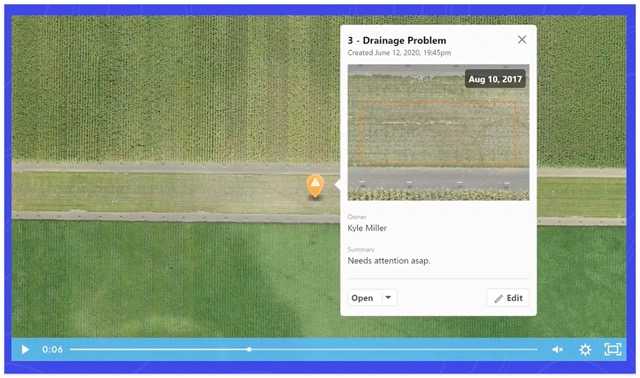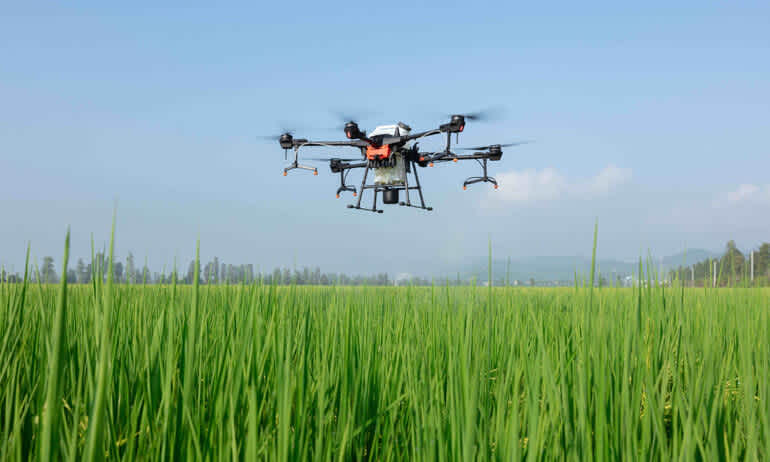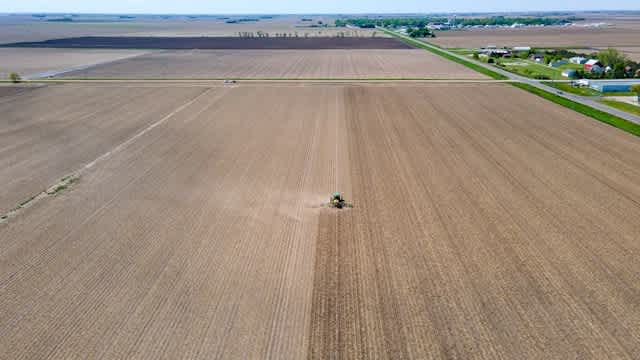Top 5 Benefits of Drones in Agriculture
Published: August 27, 2024

Drones are revolutionizing the agriculture industry, offering farmers and growers a powerful new tool to improve workflows, increase yields, and reduce costs. From precision scouting and mapping to targeted spraying and spreading, drones are reshaping the way we approach modern agriculture.
In this in-depth blog post, we'll explore the top 5 benefits of using drones in agriculture and how they can transform your farming operations.
1. Precision Scouting and Mapping
One of the primary use cases for drones in agriculture is scouting and mapping. Even consumer-grade drones are capable of capturing highly detailed aerial imagery of fields and crops, allowing farmers to quickly identify problem areas and monitor the overall health of their operations.
The process, known as photogrammetry, involves the drone flying a pre-programmed grid pattern over a field, capturing regular photographs. These images are then stitched together using specialized software like Pix4D or DroneDeploy to create an "orthomosaic" - an accurate, high-resolution representation of the ground below.

From this orthomosaic, farmers can extract valuable data, including:
Precise measurements of field size, area, and volume
Identification of crop damage, irrigation issues, and other problem areas
Detailed maps that can be overlaid with other data sources, such as soil samples or yield data
But the benefits of drone scouting don't stop there. By incorporating more advanced sensors, such as multispectral or thermal cameras, farmers can gain an even deeper understanding of their fields.
For example, the MicaSense Altum drone-mounted sensor can detect subtle differences in plant health, helping to identify areas in need of targeted intervention.
This precision scouting and mapping data can be massively beneficial for modern agriculture, allowing farmers to make more informed decisions, optimize their inputs, and improve overall efficiency.
2. Targeted Aerial Spraying
Another key application of drones in agriculture is targeted aerial spraying. Drones equipped with specialized spraying payloads can be used to apply herbicides, pesticides, and other liquid treatments directly to the fields, with a high degree of precision and efficiency.
One of the standout examples in this category is the DJI T20 - a powerful, autonomous spraying drone capable of covering nearly 30 acres per hour with its 21-foot spray width. By leveraging the drone's ability to fly pre-programmed routes and automatically return for battery or payload swaps, farmers can cover large areas quickly and efficiently, without the need for costly and time-consuming manual spraying.

But the benefits of drone spraying go beyond just speed and efficiency. By coupling the drone's spraying capabilities with the detailed mapping and scouting data gathered earlier, farmers can precisely target only the areas of the field that require treatment. This reduces material waste, lowers environmental impact, and ensures that inputs are applied exactly where they're needed most.
Precision agriculture has never been more achievable, and drone-based spraying is at the forefront of this revolution.
3. Autonomous Spreading and Seeding
In addition to targeted spraying, drones can also be used for the autonomous spreading and seeding of granular materials, such as fertilizers and cover crops.
The DJI Agras series can be quickly converted to a spreading configuration, capable of dispersing up to 33 pounds of material per minute. This makes them an ideal solution for tasks like cover crop application, where drones can quickly and efficiently spread materials across large areas without compacting the soil.
One of the key benefits of using drones for cover crop application is the ability to apply the materials at any time of year, without the need for heavy equipment that can damage the soil structure. By flying over the field and dispersing the cover crop seed or granules, drones help to improve soil health, reduce erosion, and promote weed mitigation - all while minimizing the impact on the land.
Furthermore, by leveraging the autonomous flight capabilities of drones like the Agras T20, farmers can scale up their spreading operations by flying multiple units simultaneously, covering up to 45 acres per hour. This level of efficiency and precision is simply unattainable with traditional ground-based methods.
4. Livestock Management and Monitoring
Drones aren't just transforming crop production - they're also making a significant impact on livestock management and monitoring. Farmers and ranchers are increasingly turning to drone technology to keep a closer eye on their herds and ensure their safety and well-being.
One of the primary use cases for drones in livestock management is long-distance scouting and monitoring. Equipped with high-resolution cameras, drones can quickly cover large areas, searching for the herd or identifying any potential strays. And by incorporating thermal imaging capabilities, farmers can even locate livestock at night or in dense vegetation, where they might otherwise be difficult to spot.
But the benefits of drone-based livestock monitoring go beyond just visual identification. Drones can also be used to monitor herd behavior, track movement patterns, and even detect signs of illness or distress. This data can be invaluable for making informed decisions about herd management, feeding, and veterinary care.
Furthermore, drones can be used to safely and efficiently inspect remote or hard-to-reach areas of a ranch or pasture, helping to identify potential hazards or issues that might otherwise go unnoticed.
5. Rapid Field Scouting and Damage Assessment
The final key benefit of drones in agriculture is their ability to quickly and efficiently scout fields and assess damage, particularly in the aftermath of severe weather events or other natural disasters.
Whether equipped with standard RGB cameras or more specialized sensors like thermal imagers, drones can be deployed to survey large areas in a fraction of the time it would take to do so on foot or by vehicle. This allows farmers to quickly identify problem areas, assess the extent of any damage, and make informed decisions about the next steps in their recovery efforts.

In the event of a major storm, for example, a drone can be flown over the fields to check for signs of flooding, crop damage, or infrastructure issues. This information can then be used to prioritize repair and remediation efforts, ensuring that the farm or ranch can get back up and running as quickly as possible.
Additionally, the aerial perspective provided by drones can reveal insights that might be difficult or impossible to glean from ground-level inspections. By capturing a comprehensive, bird's-eye view of the affected areas, farmers can better understand the full scope of the damage and develop more effective recovery strategies.
Path to Increased Monitoring
Drones are often an under-looked solution in the agriculture industry, offering farmers and growers a powerful new tool to improve workflows, increase yields, and reduce costs. From precision scouting and mapping to targeted spraying and spreading, drones are reshaping the way we approach modern agriculture.
Whether you're a large-scale commercial operation or a small family farm, incorporating drone technology into your agricultural practices can provide a significant competitive advantage.
By leveraging the benefits outlined in this blog post, you can optimize your inputs, improve your overall efficiency, and ultimately, grow healthier, more productive crops.
Keep track of all your cattle with the #1 Cattle Management Software
Try out Ranchr today for free